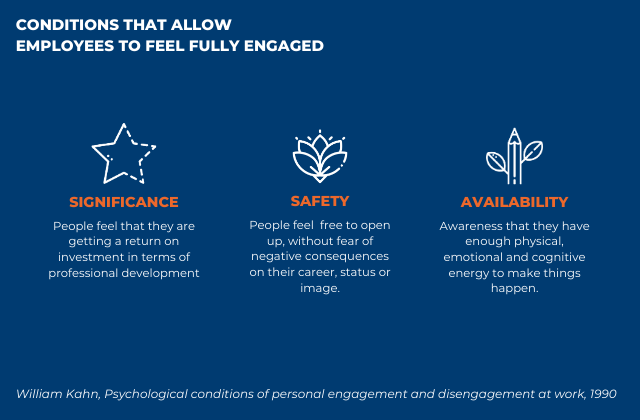6 January 2021
In the “new normal”, high employee engagement contributes towards raising wellbeing levels, improving health and reducing the risk of burnout.
Employees that are highly engaged increase profitability by +21%, raise productivity by +20%, and boost client loyalty up to +10% (source: Gallup).
Discover how you can improve employee development and engagement in just 3 steps.
Lockdown restrictions are easing and the government is encouraging people to go back to the workplace. It’s highlighted the need for a “now normal”. We now know that we can’t go back to how things were. Instead, we need to move with this evolving situation to reach the next normal. It’s a transition in itself, but this version of normality holds some similarity to our lives pre-Covid.
Being attentive to people and standing beside them is now more important than ever. It helps them to reposition themselves. Essentially, they will play a key role in determining the company’s survival. Adopting employee engagement practices has the advantage of increasing productivity levels, lowering stress levels and boosting wellbeing across the company.
According to William Kahn, employees need to recognise these three psychological conditions before feeling fully involved:

In one of Gallup’s recent studies, they confirmed that teams with the highest engagement levels get better results. That’s a 21% increase in profitability, 20% more productivity and 10% increase in customer loyalty. The benefits go beyond the company accounts. Highly engaged employees are also proven to be healthier and less at risk of burnout.
According to Gallup, focusing on employee engagement must be prioritised by companies as they change the way they approach employee development. Companies that shift the focus to a culture of internal growth often see engagement leaping from 20% to 70%.
But there’s more. The relationship between the two elements seems to intensify when external conditions surrounding the organization are particularly difficult. In times of crisis, a positive corporate culture can impact the company’s results even more than it would under “normal conditions”. Over the past through years of economic recession, we’ve seen a closer relationship between employee engagement and rise in company profitability. The same goes for productivity and consumer perceptions.
But that doesn’t mean that engagement grows by itself when a crisis hits. Social distancing and new ways of working through the pandemic have tested companies when trying to keep their employees engaged. It’s because employee engagement only increases when companies adopt positive organisational practices. They need to develop clear strategies to overcome the physical distance and strengthen individual participation within the company.
So how can we listen to people and help them feel accepted within the company? How can we improve employee engagement? Here are 3 steps that we can use as we navigate this period of uncertainty.
Our first suggestion is to see people for all that they are. A Deloitte study revealed that 61% of employees hide parts of their identity at work for fear of discrimination. Some feel conscious of appearing to be less focused on their work. For many, Covid has made it impossible for people to hide different aspects of their lives.
When remote working became the norm, people found themselves suddenly sharing unseen parts of their lives with their bosses and colleagues. When they were seen on screen, they weren’t just seen as professionals, but also as parents, partners and caregivers. Allowing people to bring their whole selves to work also means creating a “culture of care”, where everyone feels free to open up. It’s something that helps to reduce tension and increase shared understanding. As well as bringing all available talent to the workplace, of course.
Learning takes place in many forms, not just in formal contexts. We can learn throughout the different aspects of our lives, and the crisis has also created employee development opportunities for people and organizations. We can see the crisis as a catalyst for change and decide on the type of transformation that we want to see.
Post-traumatic literature highlights five areas of potential growth:
When people realize that they have gone through a difficult period and come out the other side having learnt important lessons, it makes them more aware of their abilities and better equipped for the future. When we consider continuous learning, working through past experiences allows them to create a new narrative surrounding change: in a constantly evolving world, reacting to unexpected events means learning to start again.
The pandemic also offers a great opportunity for companies to find answers tailored to their people’s needs. By opening listening channels, they can avoid isolation. They can also better understand the different challenges that employees are facing, identifying the best ways to support them.
Adopting a personalised approach means promoting a shared culture of change within the organization. That’s why employee development requires continuous conversations between employees and the company. It means considering the specific needs of the individual, allowing everyone to create their own journey. What’s more, they can share learnings with one another, so that they can create something new together. sense of purpose.
In transitions such as the one triggered by Covid-19, growth only happens when people walk together: companies and employees, seen and recognized in both their personal and professional capacities. Over 80 companies currently use Lifeed, such as Manpower, MSD, Reale Mutua and UniCredit. Each company has decided to transform life transitions into training grounds for soft skills that boost professional efficacy. It’s also a great tool for engaging people, improving their wellbeing and increasing productivity in the workplace.
53% of Lifeed users feel that they can reveal and use more of themselves at work. 57% feel proud of their company. The results are clear. 90% feel better and have more energy. The same percentage of people feel more involved and motivated in their daily tasks.
Want to learn how Lifeed could benefit your business? Contact us to see our live demo or try it for yourself.